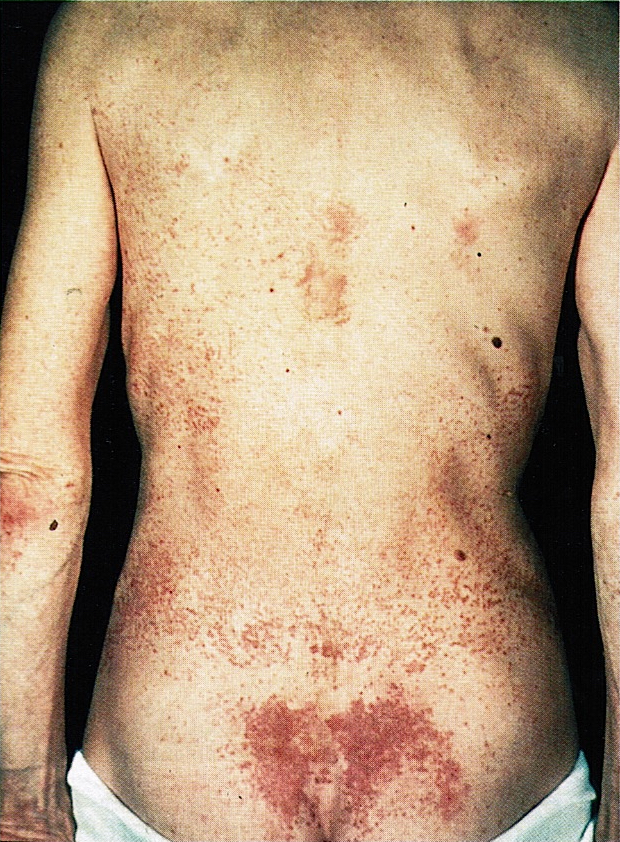Table of Contents
Definition / general | Essential features | Terminology | ICD coding | Epidemiology | Sites | Pathophysiology | Clinical features | Diagnosis | Laboratory | Radiology description | Radiology images | Case reports | Treatment | Clinical images | Gross description | Microscopic (histologic) description | Microscopic (histologic) images | Positive stains | Electron microscopy description | Sample pathology report | Differential diagnosis | Board review style question #1 | Board review style answer #1 | Board review style question #2 | Board review style answer #2Cite this page: Gonzalez RS. Glucagonoma (alpha cell tumors). PathologyOutlines.com website. https://www.pathologyoutlines.com/topic/pancreasglucagonoma.html. Accessed April 1st, 2025.
Definition / general
- Rare, poorly characterized pancreatic neuroendocrine tumor that produces glucagon
Essential features
- WHO recognized diagnosis
- Produces glucagon, akin to alpha cells of the pancreas
- Clinical glucagonoma symptoms include necrolytic migratory erythema, diabetes, weight loss and anemia
Terminology
- Necrolytic migratory erythema: skin rash of legs, perineum, groin; rash becomes blisters with central clearing, heals with hyperpigmentation but without scarring in 7 - 14 days (Am J Surg Pathol 1986;10:445)
ICD coding
- ICD-10: D37.8 - Neoplasm of uncertain behavior of pancreas
Epidemiology
- Incidence rate of approximately 2.5/100,000,000 (Oncol Lett 2018;15:2749)
- Mean age 54 years
- More common in women
Sites
- More common in tail of pancreas
Pathophysiology
- Generally sporadic
- Patients with multiple endocrine neoplasia type 1 may have multiple small glucagonomas (with better prognosis)
Clinical features
- Causes glucagonoma syndrome (necrolytic migratory erythema, diabetes mellitus, weight loss, anemia, angular stomatitis)
- Necrolytic migratory erythema may become infected
- Roughly half of cases metastasize, often to liver
Diagnosis
- Determined clinically, not by immunohistochemical positivity for glucagon
Laboratory
- Elevated blood glucagon levels
Radiology description
- MRI: low signal intensity on T1, slightly high signal intensity on T2
Case reports
- 50 year old woman with pruritic rash (Oncol Lett 2015;10:1113)
- 51 year old woman with heart failure (Endocrinol Diabetes Metab Case Rep 2014;2014:140061)
- 62 year old woman with ovarian mass and history of glucagonoma (JOP 2013;14:510)
- 64 year old woman with erythematous rash (Case Rep Surg 2016;2016:1484089)
- 68 year old man with anemia and diabetes (J Hepatobiliary Pancreat Surg 2003;10:101)
Treatment
- Surgery is only curative option
- Somatostatin analogues may relieve symptoms (Clin Endocrinol (Oxf) 2011;74:593)
Clinical images
Gross description
- Average gross tumor size is 5.0 cm
Microscopic (histologic) description
- Nests of monotonous low grade neuroendocrine cells with salt and pepper nuclei and ample amphophilic cytoplasm
Microscopic (histologic) images
Positive stains
- Glucagon (though this does not establish the diagnosis)
- Synaptophysin and chromogranin
Electron microscopy description
- Single type secretory granules similar to normal alpha cell granules (Ultrastruct Pathol 1989;13:15)
Sample pathology report
- Pancreas and duodenum, Whipple procedure:
- Pancreatic neuroendocrine tumor, WHO grade 1 (see synoptic report and comment)
- Comment: The patient’s clinical history of necrolytic migratory erythema is noted. This may be due to glucagon secretion by this tumor, which would make it a glucagonoma. Immunohistochemical stains for synaptophysin and chromogranin are positive and the Ki67 index is approximately 1.2%.
Differential diagnosis
- Nonglucagon secreting pancreatic neuroendocrine tumor:
- Must be determined on clinical grounds (Proc (Bayl Univ Med Cent) 2015;28:46)
Board review style question #1
- Which of the following is a potential clinical symptom of pancreatic glucagonoma?
- Angular stomatitis
- Hypochlorhydria
- Hypoglycemia
- Water diarrhea
Board review style answer #1
A. Angular stomatitis (though the most common finding is necrolytic migratory erythema). Hypochlorhydria is sometimes seen in somatostatinoma. Hypoglycemia is typical of insulinoma. Watery diarrhea is typical of VIPoma.
Comment Here
Reference: Glucagonoma (alpha cell tumors)
Comment Here
Reference: Glucagonoma (alpha cell tumors)
Board review style question #2
- Which of the following is necessary to confirm a diagnosis of glucagonoma in a patient with a pancreatic mass?
- Classic radiologic findings
- Clinical glucagonoma type symptoms
- Immunohistochemical positivity for glucagon
- Specific histologic findings
Board review style answer #2
B. Clinical glucagonoma type symptoms. The diagnosis of glucagonoma is made on clinical grounds in the setting of a pancreatic mass lesion.
Comment Here
Reference: Glucagonoma (alpha cell tumors)
Comment Here
Reference: Glucagonoma (alpha cell tumors)















